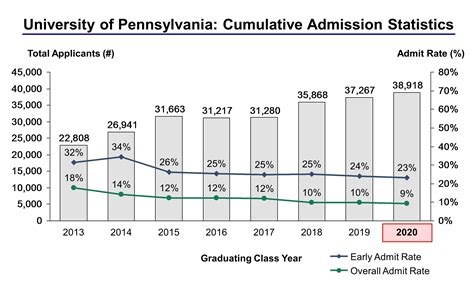Introduction
The Massachusetts Institute of Technology (MIT) and the University of Pennsylvania (UPenn) are two of the most prestigious universities in the world, known for their rigorous academics, esteemed faculty, and groundbreaking research. As a result, these institutions receive a staggering number of applications each year. In this article, we will delve into the acceptance rates of UPenn and MIT, exploring the factors that influence these rates and providing insights into the admissions process at these elite universities.

Acceptance Rates
The acceptance rates at UPenn and MIT have been consistently low in recent years, reflecting the highly selective nature of these institutions. According to data from the National Center for Education Statistics (NCES), the acceptance rate for UPenn in 2022 was 7.9%, while MIT’s acceptance rate was 4.1%. These rates indicate that for every 100 applications received, UPenn accepts approximately 8 students, and MIT accepts only 4.
Factors Influencing Acceptance Rates
Several factors contribute to the low acceptance rates at UPenn and MIT:
-
High Academic Standards: Both universities have rigorous academic standards, demanding strong grades, competitive test scores, and exceptional extracurricular activities. Students who apply to these institutions must demonstrate exceptional intellectual ability and academic competence.
-
Global Competition: UPenn and MIT attract applicants from around the world, creating a highly competitive pool of candidates. International students often face additional challenges, such as language barriers and cultural differences, which can affect their chances of admission.
-
Limited Enrollment: Both universities have limited enrollment capacity, which restricts the number of students they can accept each year. This creates intense competition for the available spots, leading to low acceptance rates.
Comparison of Admissions Processes
Although UPenn and MIT share similarities in their prestige and selectivity, their admissions processes differ in certain aspects:
UPenn:
-
Holistic Admissions: UPenn employs a holistic admissions approach, considering various factors beyond academic achievement, such as extracurricular activities, leadership skills, and personal qualities.
-
Early Decision Program: UPenn offers an Early Decision (ED) program, which allows students to apply to the university early and receive an admissions decision before the regular application deadline. ED applicants must commit to attending UPenn if accepted.
MIT:
-
Science and Engineering Focus: MIT places a strong emphasis on science, technology, engineering, and mathematics (STEM) disciplines. Students interested in these fields have a higher chance of admission compared to those in other areas.
-
Need-Blind Admissions: MIT practices need-blind admissions, meaning that the university does not consider financial need when making admissions decisions. Students from all socioeconomic backgrounds have equal opportunities for admission.
Tips for Prospective Applicants
Applying to UPenn or MIT is a highly competitive process, but there are strategies that prospective applicants can employ to enhance their chances of acceptance:
-
Excel Academically: Maintain a strong academic record with high grades and competitive test scores. Take challenging courses and demonstrate intellectual curiosity.
-
Engage in Meaningful Activities: Participate in extracurricular activities that reflect your interests, passions, and leadership abilities. Pursue activities that have a positive impact on your community or demonstrate your commitment to a particular cause.
-
Craft a Compelling Personal Statement: The personal statement is a crucial part of the application process. Use it to showcase your unique personality, values, and aspirations. Write a well-written, thoughtful, and engaging essay that reveals who you are and why you would be a valuable addition to the UPenn or MIT community.
-
Seek Recommendations from Strong Supporters: Request letters of recommendation from teachers, counselors, or mentors who can attest to your academic abilities, extracurricular involvement, and personal qualities.
Conclusion
Applying to UPenn or MIT is a challenging endeavor, but it is also an opportunity to demonstrate your exceptional talents and aspirations. By understanding the acceptance rates, factors influencing admissions, and strategies for prospective applicants, you can increase your chances of success in the highly competitive admissions process at these esteemed universities.
Additional Tables for Reference
| Year | UPenn Acceptance Rate | MIT Acceptance Rate |
|---|---|---|
| 2019 | 8.4% | 4.1% |
| 2020 | 7.9% | 4.0% |
| 2021 | 7.3% | 3.9% |
| 2022 | 7.9% | 4.1% |
Frequently Asked Questions
1. What are the chances of getting accepted to UPenn or MIT?
The chances of getting accepted to UPenn or MIT are highly competitive, with acceptance rates consistently below 10%. In 2022, the acceptance rate for UPenn was 7.9%, and for MIT, it was 4.1%.
2. Is UPenn or MIT more selective?
MIT has a slightly lower acceptance rate than UPenn, making it the more selective institution. In 2022, MIT’s acceptance rate was 4.1%, compared to UPenn’s 7.9%.
3. What is the Early Decision (ED) program at UPenn?
UPenn offers an Early Decision (ED) program, which allows students to apply to the university early and receive an admissions decision before the regular application deadline. ED applicants must commit to attending UPenn if accepted.
4. Does MIT practice need-blind admissions?
Yes, MIT practices need-blind admissions, meaning that the university does not consider financial need when making admissions decisions. Students from all socioeconomic backgrounds have equal opportunities for admission.
